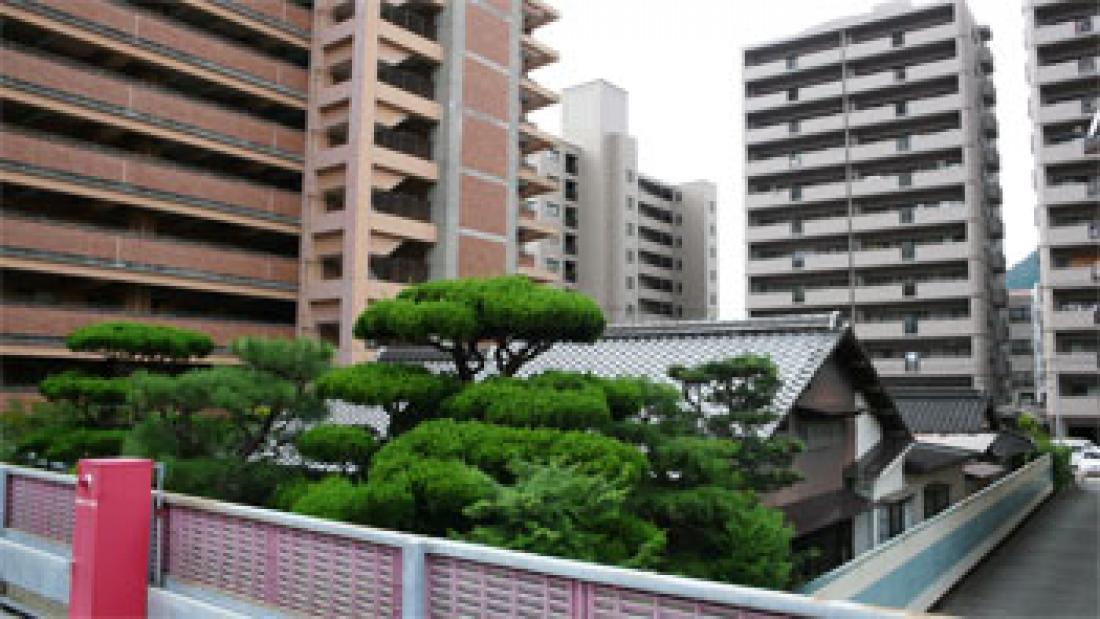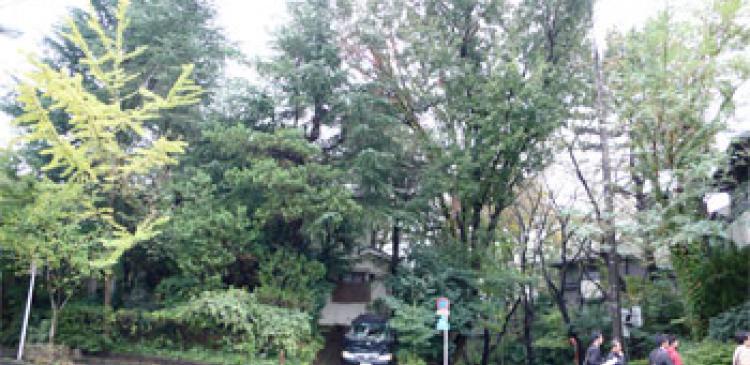Traditional house with beautiful garden trees and a group of modern high-rise apartments surrounding it
The idea of building communities that people will continue living in and issues faced
Japan has faced the social issues of a decreasing population and population aging for quite some time. For example, it is important to consider residential policy for regional cities in an integrated manner with urban planning that will lead to the rebirth and revitalization of central urban areas, and when implementing these measures gaining the cooperation of people through local networks is essential. In addition, it is also important to implement the formation of compact urban areas through control of land use in the suburbs and consolidation of functions in the urban center in a manner that is integrated with urban reorganization for that purpose.
In the past, the sphere of living was formed with its basis on social human relationships such as regional ties, blood ties, and work ties. Meanwhile, in modern society, the scope of living by people and consumption and economic activities have expanded complexly beyond municipalities and built-up areas based on various living styles and changing life stages, and the sphere of living has been formed as these elements overlap. However, ideas for the spatial image and future targets of community building in response to the diversification of living styles and changing life stages in this modern network-based civil society have not been shared throughout regional areas.
While the building of communities that people will continue living in to be led by local residents and local landowners should be conducted in an integrated manner with the urban planning and community building measures implemented by municipalities, this is not always necessarily the case in reality. For example, while the construction of high-rise apartments and the development of small detached houses in the inner-city areas of regional cities can be considered as a positive development from the perspective of increasing the population of inner-city areas, it is not really consistent with the real purpose of community building that consists of the rebirth of the surrounding living environment and improving the attractiveness of central city areas, and for this reason such measures can hardly be deemed to lead to true regional rebirth and urban district revitalization. Normally cities must have accumulated many local resources such as the natural environment, the historical and cultural environment, and the social welfare and educational environment that can make significant contributions to the renewal and improvement of living environments in cities, if effective social investments are made. From this perspective, it would be socially significant to consider the various resources that have been accumulated in regions in terms of building living environments and to work to restore the value of these resources.
Creating new value with living environment resources and incorporating them in community building
In the restoration of apartment complexes that has been implemented in areas such as housing developments in the Tokyo metropolitan area in recent years, concurrent with the seismic reinforcement and renovation of buildings that were built during the period of high economic growth, residential units are being converted into a mixed variety of living environments including shared-houses for young people, residences with rental vegetable gardens, and rental houses combined with small-scale multi-function social welfare services for elderly people, and such efforts to create new value for old apartment complexes have produced results. This is an effective method of community building aimed at restoring living environments to support distinctive life styles going forward.
Meanwhile, even if it is an era of a decreasing population and population aging, there are social demands for styles of residences equipped with living support and social welfare services that elderly people can feel secure living in. In addition, living environments that maintain and form positive mutual relationships with natural environments including forests, satoyama woodlands and water systems close to where people live and farmlands on the outskirts of cities could be accepted as a form of pastoral living style in cities.
Urban green areas such as satoyama woodlands and forests that are used as a place of relaxation for residents and are preserved and maintained in a manner integrated with the development of residential areas are important not only for their environmental and scenic value, but also for providing a forum for mutual interaction between residents and generating various forms of civil society participation. These types of satoyama woodlands and forests can be seen as a form of a local commons in urban areas, and are a good example of creating new value with the shared social resources of a community. However, in most cases these types of local commons are maintained and managed through the contributions from community building activities based on the goodwill of landowners and the selfless volunteer activities of specific residents’ groups. As these types of initiatives contribute to the building of a living environment with shared benefits for the entire community, it is important for them to be implemented based on area management frameworks in which such commons are maintained, preserved, and used by the citizens and residents who enjoy their benefits, and it would be preferable to position the initiatives as a community building project in which the social costs can be covered by the community overall as appropriate.
Adopting selectable community building initiatives that leverage region-specific living environment values
The creation living environments in which residents will maintain, manage, and use the region-specific historic, cultural, and natural environment to continue to live in is not something that can be left up to the profit-driven real estate and residential development market as has been done up until now. It is necessary to first plan future community building goals that can be shared in communities, and gain the frameworks and people’s cooperation that can bring together and continuously implement social community building projects in order to achieve these goals. In consideration of this, the following roles are required for community building going forward.
1. The creation of new value for living environments that incorporates various lifestyle qualities and regional characteristics in response to long-term fluctuations in urban and regional structures (such as degeneration and encroachment) accompanying the decreasing population and population aging.
2. The proposition of living environment community building goals and local rules that can be shared by the local community, and the creation of a framework for coordination and integration with urban planning implemented by municipalities.
3. The creation of a framework for passing down region-specific natural environments and historical, cultural, and regional characteristics and the creation of new value that incorporates these local resources in living environment community building.
4. The creation of local platforms that serve as the base for a broad range of civic activities including culture and arts, sports, education, and social welfare, and the creation of community building goals and phased achievement programs in conjunction with these platforms that can support various living styles and life stages.
5. The creation of social frameworks that allow for local governments and community building specialist to provide continuous support for local residents and local landowners that are responsible for community building.
As described above, in order to create communities that people will continue living in going forward, in addition to local safety and transportation convenience and the level of urban infrastructure development through public works that serve as basic indicators for real estate values, creating living environment value that incorporates local resources is essential. For this reason, in the future it is important for local people to create community building goals and visions with the cooperation of local governments and experts that are capable of supporting local changes and fluctuations in regional structures that can be expected with the drastically decreasing population and rapid population aging, and to implement community building for living environments based on local platforms led by citizens and local landowners.
ABOUT THE AUTHOR
Takashi Ariga
Professor, Graduate School of Creative Science and Engineering, Waseda University, Ph.D. (Environmental Planning and Urban Design)
Professor Ariga was born in Tokyo and graduated from the Department of Architecture, Faculty of Science and Engineering, Waseda University and completed the master program (urban planning research) at the same university. Subsequently, after working at the Seiyo Corporation, he studied abroad as a Ph.D. candidate at the College of Environmental Design, University of California at Berkeley. After returning to Japan, he served as an assistant professor at the Department of Environmental Engineering and Architecture, Graduate School of Environmental Studies, Nagoya University. He has held his current post since 2006.
[Area of Specialization]
Areas of specialization include urban design, urban space and environment design, research on building living environments, and urban planning.
Academic societies]
Professor Ariga currently serves as Director, Delegate, and Chair of the Research Committee on Urban Planning and Design of the Architectural Institute of Japan (AIJ), as well as the General Manager of the Living Environment Management Subcommittee and the Urban Planning Division of the Special Research Committee on Building Communities with Strong Recuperative Strength from Major Disasters of the AIJ.
[Committees, etc.]
He currently serves as the Chair of Historic Scenery Maintenance and Improvement Plan Council and a member of the Scenery Council of Shirakawa-shi, Fukushima Prefecture, a member of the Development Review Council of Kawaguchi-shi, Saitama Prefecture, a member of the Outdoor Advertisement Review Council for the Tokyo Metropolis, a member of the Community-Building Scenery Review Council of Suginami-ku, Tokyo, and Deputy Chair of Urban Redevelopment Project Post-Evaluation Committee of Minato-ku, Tokyo. He served as the Selection Committee Chair for the Aichi Urban Design Architecture Award in Aichi Prefecture and as member of the review committee for the JICA E-JUST Egypt-Japan University of Science and Technology Campus International Design Competition.
[Awards]
He won 1st Prize, Special Commendation of the IFHP International Student Urban Design Competition in 1986 and the Ono Azusa Memorial Award of Art from Waseda University in 1986.
[Works]
His numerous major works include Urban Planning International Terminology Dictionary [Toshi Keikaku Kokusai Yogo Jiten] (co-authored, Maruzen, 2003), The Community Building Design Process [Machizukuri Dezain no Purosesu] (co-authored, Architectural Institute of Japan, 2004), Community Building Textbook Edition 8, Building Community Landscapes [Machizukuri Kyokasho Dai 8 Kan: Keikan Machizukuri] (co-authored, Architectural Institute of Japan Community Building Support Committee, 2005), Joint Community Building by Regions and Universities [Chiiki to Daigaku no Kyoso Machizukuri] (co-authored, edited by Architectural Institute of Japan Community Building Support Committee, Gakugei Publications, 2008), Landscape Act Utilization Guide [Keikanho Katsuyo Gaido] (written and edited by Architectural Institute of Japan, Gyosei, 2008), Building Campuses Now [Ima kara no Kyanpasu Zukuri] (co-authored, Architectural Institute of Japan, 2011), and Karatsu: Urban Reorganization Making an Attractive Town for Walking [Karatsu: Toshi no Saihen—Arukitakunaru Miryoku aru Machi he] (co-authored, Architectural Institute of Japan, Kajima Publishing, 2012)




